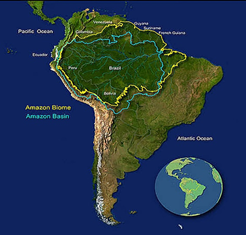

Context
Brazil’s Amazon Summit held in Belem, organized with a roadmap to protect tropical rainforests that was welcomed as an important step in countering climate change has concluded recently.
About
- The leaders of eight South American nations that are home to the Amazon have met at a two-day summit ending in the Brazilian city of Belem, with the task of agreeing to a list of unified environmental policies and measures to bolster regional cooperation and stop the destruction of the rainforest.
- The summit of the Amazon Cooperation Treaty Organization (ACTO) adopted what host country Brazil called a “new and ambitious shared agenda” to save the rainforest.
Key points of the Summit:
- Against Deforestation: The final joint declaration, called the ‘Belem Declaration’, created an alliance for combatting forest destruction, with countries left to pursue their individual deforestation goals.
- Protection of Indigenous rights and society: The nearly 10,000-word road map asserted Indigenous rights and protections, while also agreeing to cooperate on water management, health, common negotiating positions at climate summits, and sustainable development.
- Establishment of a Science body: The declaration additionally established a science body to meet annually and produce authoritative reports on science related to the Amazon rainforest, akin to the United Nations’ International Panel on Climate Change.
Amazon Cooperation Treaty Organization (ACTO):
- ACTO was formed in 1995 to protect and manage the Amazon.
- The group aimed to recognize the reality that the Amazon rainforest crossed borders and needed international management, but also to protect the Amazon countries' sovereignty over their territory.
- Member countries: Bolivia, Brazil, Colombia, Ecuador, Guyana, Peru, Suriname and Venezuela are members of the organisation.
|
All the countries at the summit have ratified the Paris climate accord, which requires signatories to set targets for reducing greenhouse gas emissions. |
Problems unaddressed:
- The summit stopped short of environmentalists’ and Indigenous groups’ boldest demands, including for all member countries to adopt Brazil’s pledge to end illegal deforestation by 2030 and Colombia’s pledge to halt new oil exploration.
- It also did not fix a deadline on ending illegal gold mining, although leaders agreed to cooperate on the issue, and did not include shared commitments to zero deforestation by 2030.

The Amazon forests:
- These are large tropical rainforests occupying the drainage basin of the Amazon River and its tributaries in northern South America and covering an area of 6,000,000 square km.
- Tropical forests are closed-canopy forests growing within 28 degrees north or south of the equator.
- They are very wet places, receiving more than 200 cm rainfall per year, either seasonally or throughout the year.
- Temperatures are uniformly high - between 20°C and 35°C.
Geographical facts:
- Such forests are found in Asia, Australia, Africa, South America, and Central America, Mexico and on many of the Pacific Islands.
- Comprising about 40% of Brazil’s total area, it is bounded by the Guiana Highlands to the north, the Andes Mountains to the west, the Brazilian central plateau to the south, and the Atlantic Ocean to the east.
Threats to Amazon forests:
- Narco-deforestation: is an infamous phenomenon in South American countries, involves funneling drug profits into environmental crimes like land grabs, illegal mining, poaching and illicit logging.
- Ignored Indigenous communities: A lack of government enforcement does not incentivize businesses or communities to plan for long-term stewardship. The Indigenous communities that have inhabited the area for generations have lifestyles that naturally protect and sustain the Amazon ecosystem.
Steps taken:
- The Brazilian space agency INPE employs satellite-based systems providing rapid alerts about deforestation patterns.
- These tools helped detect the more than 60 percent drop in deforestation in the Amazon compared to the previous year.


